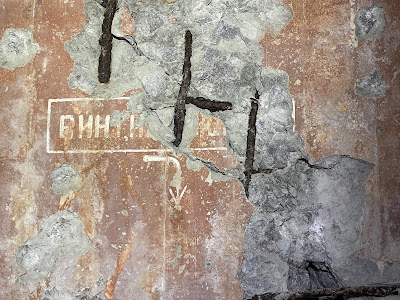
We had heard a rumor of a potentially previously unknown bunker in Siuntio. Let's call it the Hoivakodin Bunkkeri (Retirement Home Bunker). It turned out to be accessible -- if you don't mind passing through pieces of concrete hanging by rusting, twisted rebar. And it was a massive one! Another ZIF-25 model bunker, i.e., a two-floor bunker with several entrance tunnels and a side mountain gun port.
This seems like an appropriate time to remind every reader that VISITING UNDERGROUND STRUCTURES IS DANGEROUS AND NOT RECOMMENDED BY THIS BLOG. At all. And we in particular do not recommend anyone to visit partially blown-up bunkers, because that's just INSANELY DANGEROUS.
As has been the case with all the ZIF-25s that we've visited, they've been quite carefully fully destroyed, much more carefully apparently than the smaller bunkers that sometimes are somewhat intact. The main side walls and roofs have taken significant damage, but are generally standing, but entire insides are otherwise crushed, e.g., doors, intermediate floors, etc. In addition, the gun ports have been made unusable by cementing them shut.
As many as 300 bunkers have been laid out in the Porkkala area that was occupied by Soviet Union after World War II. Fortunately, the area was returned to Finland after just slightly over a decade. The bunkers were built to defend against a NATO invasion, or perhaps an invitation from the Finnish military. Either type of attack was of course entirely imaginary situation, but it didn't stop the presumably significant effort to build these bunkers by such large numbers. It must have taken a lot of workers -- even if in part with forced labour -- and material such as steel, concrete and machines to make them.
Looking at the placement of the bunkers, the central idea seems to have been to surround every patch of open fields by preferably two bunkers that can defend against the forces landing by airplane (for instance).
Fast forward 70 years, and the bunkers are rusting, sometimes stalactites are building up, water is flooding some, nature will eventually take over everything. In the mean time these structures are a reminder of a dark past. And sometimes beautiful, dark spaces with occasional glimpse of light from explorers headlamps. And a few crawling or flying friends are joining the fun: butterflies, insects, bats even.
We had a visitor from overseas, an Australian caver, Alan, who we took to see the bunkers. I suppose the Russian bunkers are in short supply in his home land, so hopefully we were able to provide a new experience. The Finnish caves are a bit small by anyone's standards, but we can maybe provide man-made alternate versions instead.
We also had local cavers, Jukka and Johanna who have a lot of experience in Finnish caves, but who had not visited the Porkkala area bunkers before. They were particularly keen on exploring the fauna in the bunkers. Amazingly, when someone who knows something actually looks closely, they start to be able to point to the living things in place where I had though there wasn't really anything.
Here are some pictures from the new bunker. Look, stalactites:


Entrance:

Inside:


Text. What does it say?

We also visited another, old known bunker in Siuntio. Here's Ralf behind some re-bar:
Butterflies:
Entrance:
Johanna and Jukka looking at what's flying or crawling:


















































